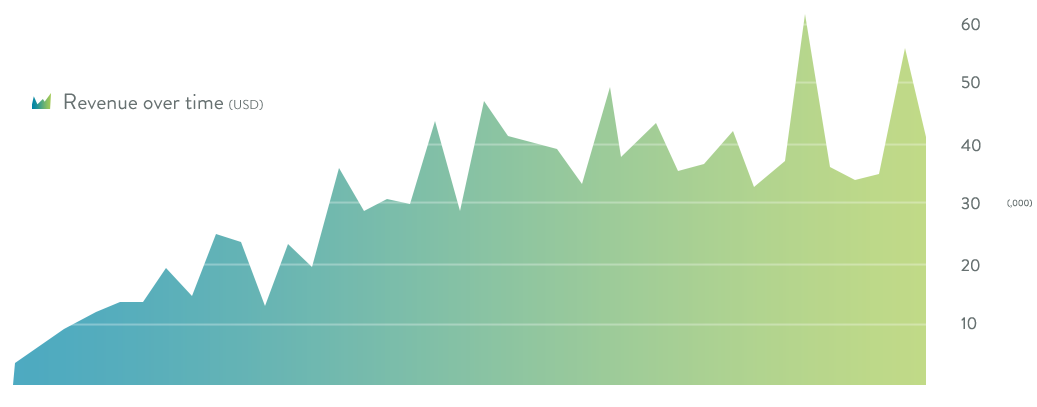I’m a sucker for numbers. Big, complicated, ugly-ass numbers. It defines the way I do business; strategic, process-driven, pragmatic and above all, ambitious. Digging back through my historical business data and making it work for future business strategy is something that gets me out of bed every day.
Today I stumbled across a pretty significant number.
But first, some context.
Three years ago (almost to the day) I left my “yeah, I guess it’s okay” job as a designer/marketer at a larger business with a vision; to do freelancing right this time.
I’ve documented my past failures so we won’t go over old ground here but suffice it to say I had all the same feelings you’re probably having now:
- I struggled to get a steady flow of leads
- My income was just too unstable to rely on
- I wasn’t really sure how to capitalize on the good months
- Nobody really knew who I was, so was stuck with low-end clients
So back to today, I stumbled across a pretty significant number.
“Holy shit, I just hit $1m in lifetime revenue.”
To be exact, I had just hit $1,003,784.99. Gulp.
Three years ago I founded my “something”; packing nothing more than a laptop, one rented desk in a shared workspace, ten digits at the end of two arms, and one vision. Today I have a self-sufficient, multi-faceted web agency (Tone), along with other offshoots, capable of operating – and growing – without my day-to-day presence.

I must stress this is a cumulative figure, over that period and we do of course now have operating costs beyond my own salary but what I wanted to share in this post was just a sprinkling of the fundamental insights that took my tiny freelance business to this significant milestone.
I’m no millionaire yet. I haven’t made it yet. What I do have now is choice, a touch of freedom to tell my story on Freelancelift and hopefully give anyone who cares to listen a leg-up with their own freelance endeavour.
You may not want to build an agency, and this isn’t the point here. You may not want a team, you may not want more than one client at a time. That’s all okay and I fully accept that.
Truth be told, it wasn’t a track I purposely followed either I was just fortunate to put into play some crucial strategy elements which ensured I had no option but to scale up to manage demand.
I’m sure you’d rather have that “nice problem” of having too many clients than not enough, right?
I needed to write this book.
It is possible to build a business which (over time at least) will turn into a $1m entity, and no, you don’t need to ‘scale up’ to do it. You can find out more about the book ‘Stop Thinking Like a Freelancer’ which has a video walkthrough for you to take a look through.
The book has become a top seller on Amazon in the “freelancer book” category.
So here goes, a breakdown of the seven key areas you need to have cemented in place before even looking toward that seven figure goal.
1. Stop thinking like a freelancer
As a single-person business its easy to think that you’re somehow exempt from that word… ‘business’.
This is what keeps most freelancers thinking like, well, freelancers. Screw that. You have a product (service), you have customers, you need to deliver your product efficiently, you need to find new clients and you need to turn a profit to survive.
Sound familiar? That’s right, you’re a business. It’s the same for you as it is for Google, Facebook and MegaCorp Inc so why do most freelancers limit themselves to run-of-the-mill freelancer blogs, same-same books and so-so advice that perpetuate the same message continually.
You need to think bigger, to stop thinking like a freelancer.
2. Be the specialist, even when you’re not
A lot of marketing is about perception. Is your prospective client more likely to go for the person that has demonstrable experience and a raft of successes with businesses like theirs? Or with the freelancer who has experience across all sectors?
In big business these are known as ‘verticals’. Specific market sectors in which a supplier can be a specialist, for a more bespoke overall service. But there’s a hack.
If you have clients in different sectors that you can loosely group together why not create landing pages or sub sections of your site which address the concerns, needs and fears this specific vertical has?
Grouping your past experience in this way ensures you can still be the specialist, even when you’re not. If you really are the specialist then you need to build a brand around that, don’t just be ‘John Smith, freelancer’ be the brand that really makes a difference to businesses in your space.
“Just solve the problem. the more you can align the positioning of your product / service to the outcome the client wants the better chance you have of making the sale. The risk factor is much lower for the client taking on the investment.”
Brennan Dunn on Freelancelift Q&A
3. Understand your core purpose
Big business has understood for some time that marketing, when broken down equates to positioning and succinct messaging which makes the likelihood of the sale greater.
If you can build a meaningful core message that positions you in a circle outside of “the herd” you have something incredibly powerful.
What is your reason for being?
Does that push the buttons of your audience? (tip: it should).
How is life different for your prospects with your service? Do you do it faster, cheaper, smarter? Does your client roster speak for itself? What results have you achieved for others? How does that relate to the sensitivities of your ideal client persona?
Is this consistent throughout your site, social media and wherever you or your brand is mentioned? (tip: it should be)
If you can put together a big idea, a unique picture of your business it anchors your whole outlook and reverberates through every touchpoint a prospect or client will experience from you.
4. Know you’re not exempt from ‘marketing’
Sure, you’re a one-person business and yes, you only need a handful of clients on a monthly basis to make it pay but this does not exempt you from pushing your message.
Like a business of any size you have operating costs, you have a requirement to make profit to survive and you have a service to help you do that. But first, your would-be client needs to know your name.
Do marketing like a business, not a freelancer.
It starts with considering yourself a brand, even as a freelancer sat behind a laptop in the coffee shop down the street. If you think of the stand-out freelancers who are making big moves (think Orman Clark, Elliot Jay Stocks, Sacha Grief) you’ll find that they have built brands at the earliest opportunity and almost considered themselves an employee of that brand.
This mindset has seen their businesses grow exponentially and although now they have probably grown beyond ‘freelance’ work I’d hazard a guess that the reputation they have built up could allow them to command any pricepoint for their work, should they wish to go back out to market.
5. Ditch freelancer exchanges as quickly as you can
Freelancer exchanges are double-edged sword. On the one hand they provide you with the opportunity to grow your reach via a captive audience of ready-made buyers, on the other hand you’re expending vital energy in an online cattle market.
Your would-be client looks on while your online persona is dragged, paraded through the mud amongst a crowd of other beleaguered cattle in the herd all hoping for the farmer with the greenest pastures.
We all know how the story ends for the cattle at the market and unfortunately the same can be said for freelancers who get clients from freelancer exchanges. There is a reason top bracket freelancers aren’t on Elance.
Its very much a lottery who you’re going to end up with, and while death isn’t necessarily on the cards you can certainly end up in a lot of pain with a poor quality client.
It’s a much better idea to set yourself away from the herd, ensure you build an online reputation which enables you to generate leads, interest and clients without needing to bid for work on freelancer exchanges.
6. Develop your “Me Project”
The most difficult part of re-imagining your freelance world is actually separating out the time it takes to make it happen. You may have some ideas based on the points above but finding time to action them is another matter.
In a recent Q&A session with Corbett Barr, we talked about developing a ‘Me Project’ – investing time in your own self-improvement. This philosophy of ‘taking yourself on as a client’ is something I advocate throughout Freelancelift.
“As a freelancer, you should be able to say: For X hours per week I’m going to be working on my ‘Me Project’, creating content and building things that are going to be better for my business in the long term.”
Corbett Barr on Freelancelift Q&A
The process of developing content, whilst initially pays very few dividends is a long-term investment in your business growth. Corbett advocates developing a “Me Project”, where you are in effect one of your more demanding clients.
By working this way you can allow, then justify time spent on developing content and building the most important brand you’ll ever work for… yourself. Try setting aside 4 or 5 hours per week to work on content, build products or side projects which will elevate your online voice in the long term as well as provide a secondary income for the short term peaks & troughs.
7. Bill on value provided, not time spent (hourly rates don’t matter)
Whether you know it or not, pricing is almost always value-led. The price you are comfortable paying for something is directly related to the value you feel you’re going to get from it. If everyone bought on price alone without appreciation of value we’d all drive a Datsun.
Put simply you should bill based on the value you provide, not the time you spend.
Therefore if your price is deemed too high, in your clients’ eyes your value is deemed too low for your pricepoint. The amazing paradox here is that you control the value your client perceives; hence it is you who dictates whether a price is too high.
You should look to drop hourly billing as quickly as possible, instead switching to a value-based ‘project price’.
You can check out my free book ‘Hourly Rates Don’t Matter’ for some practical tips on making that work for you.
In summary
As covered above, this is a significant personal milestone for me hence I’m considering this a mini-celebration. I’ve been able to leverage the support of a small team to achieve this milestone and I’ve done so by harnessing some business principles I now consider the “norm”.
Over the next few weeks I’m going to be breaking down some of the ideas above, adding more videos, a series of new posts and talking with more freelancers-done-good in my Freelancelift Q&A sessions. If that sounds like something you’d like to keep tabs on, I’d love for you to create a Freelancelift account (it’s free) and I’ll put you on a two week course which breaks down exactly where to start.
So I ask again, do you really think its possible to build a $1m freelance business?
Click here to check out the modules and join for free
Learn anything? Please share
When you’re held ransom by client work and income instability how are you supposed to find time to work on “growth” (whatever that means).
- Make freelancing more stable
- Repel 'bad apple' clients
- Beat "treading water" cycles
- Multiply online exposure
Exclusively on Amazon






